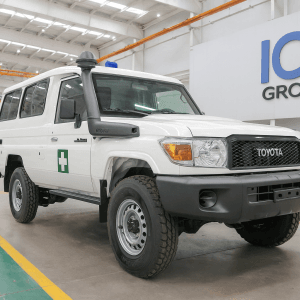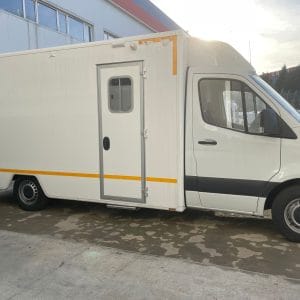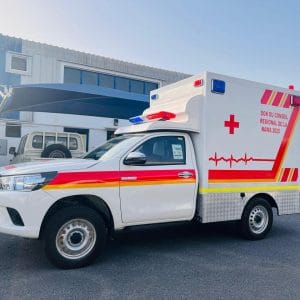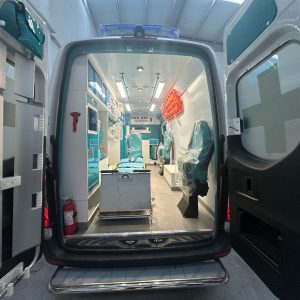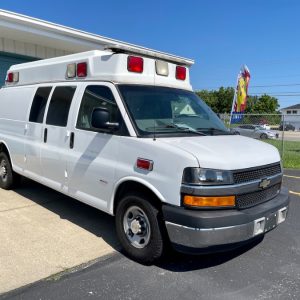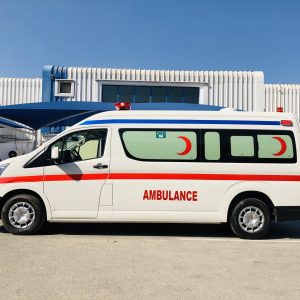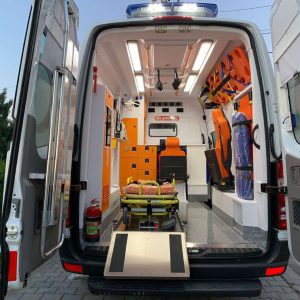Best Ambulance Manufacturers; Ambulances are emergency medical vehicles designed specifically for transporting patients in need of urgent medical care. They play a vital role in healthcare systems around the world by providing rapid pre-hospital treatment and transportation to medical facilities.
An ambulance is equipped with specialized medical supplies and equipment that allow emergency medical technicians (EMTs) and paramedics to assess, treat, and monitor patients at the scene and en route to the hospital. The interior is designed to optimize patient care, with a stretcher for the patient, seating for medical personnel, cabinets and drawers for supplies, and various medical devices.
The main purpose of an ambulance is to bring life-saving equipment, medications, and personnel to the patient and then transport the patient safely and quickly to the hospital for further care. They are mobile emergency rooms, allowing critical medical interventions to be performed outside of the hospital. This helps reduce morbidity and mortality associated with medical emergencies and trauma.
Ambulances also facilitate efficient triage, transporting patients to the most appropriate facility for their condition. With their flashing lights and sirens, they can navigate through traffic and minimize delays that could be detrimental to patient outcomes. The advent of ambulances has made emergency medical services more systematic and effective.
Best Ambulance Manufacturers History and Evolution
The history of ambulances spans centuries, with roots dating back to ancient times. Horses and carts were used to transport the injured and sick as early as the 900s AD. During the Crusades in the 11th century, a group called the Order of St. John ran hospitals and provided ambulance services.
In the late 1700s and early 1800s, horse-drawn wagons specifically designed to carry patients evolved into formal emergency medical transport services. These were operated by hospitals and included medical supplies and doctors to provide care en route.
The late 1800s saw major innovations that helped shape modern ambulances. The first motorized ambulance was introduced in Chicago in 1899. This allowed for faster transport. In the early 1900s, cars and trucks began replacing horse-drawn wagons. Radios were installed in the 1930s, improving communication and coordination.
Key developments in the mid-1900s propelled ambulances into the modern era. The first mobile coronary care units equipped with defibrillators appeared in the 1960s. On-board medical equipment became standard. Emergency medical services (EMS) systems were established to train ambulance personnel as paramedics and EMTs.
Advances continue today with new vehicle types, medical technology, digital communications, and more. Ambulances have evolved significantly from simple transport wagons into specialized emergency response units with life-saving capabilities.
Types of Ambulances
Ambulances come in a variety of types to serve different purposes. The main categories are:
Emergency Transport
Emergency transport ambulances are designed to respond to medical emergencies and transport patients to the hospital. They are equipped with life-saving equipment and staffed by EMTs or paramedics. Common types of emergency ambulances include:
- Basic Life Support (BLS) – Provides basic medical care like CPR, bandaging, etc. Usually staffed by EMTs.
- Advanced Life Support (ALS) – Provides more advanced care like starting IVs, intubating, administering drugs. Staffed by paramedics.
- Critical Care Transport – Used for transporting critically ill patients who need intensive monitoring and treatment. Staffed by specialized nurses or physicians.
Patient Transport
Patient transport ambulances provide non-emergency transportation between healthcare facilities. They do not need the same specialized equipment and staffing as emergency vehicles. Some examples include:
- Basic Ambulance – For stable patient transfers like nursing home to doctor appointments. Staffed by EMTs.
- Neonatal Ambulance – Equipped with incubators and life support systems to safely transport fragile newborns.
- Bariatric Ambulance – Oversized cabin and equipment to accommodate obese patients up to 1,000 lbs.
Specialty Vehicles
There are also specialized ambulance vehicles designed for unique situations, such as:
- Off-Road Ambulances – Built on 4×4 chassis to reach patients in rough terrain or disaster sites. May have tank tracks instead of wheels.
- Air Ambulances – Fixed-wing aircraft and helicopters equipped as “flying ICUs” to rapidly transport critical patients.
- Armored Ambulances – Reinforced with armor plating for use in conflict zones. Provides protection from ballistic/blast threats.
- Mobile Stroke Units – Specialized units equipped with CT scanner to diagnose strokes in the field and hasten treatment.
- Mass Casualty Ambulances – Extra-large vehicles designed to carry multiple patients in a disaster response scenario.
Best Ambulance Manufacturers Key Features
Ambulances come equipped with various features and equipment to provide medical care while transporting patients. Some of the key features and components include:
Patient Compartment
The patient compartment is the back interior section of the ambulance where patients are transported. This area is designed to provide medical care and monitoring during transit. The patient compartment contains a stretcher or gurney to secure the patient, seating for medical providers, storage for equipment, and often advanced life support devices. Considerations like climate control, lighting, accessibility, and ergonomics all factor into an optimized patient compartment layout.
Equipment/Medical Devices
Ambulances carry a range of medical devices and equipment to assess, monitor, and treat patients while in transit. This may include EKG monitors, defibrillators, pulse oximeters, blood pressure cuffs, oxygen delivery systems, suction units, and more. Emergency medical service providers determine the necessary equipment based on protocols and anticipated patient conditions. More advanced life support ambulances carry a broader range of equipment compared to basic life support vehicles.
Safety Features
As emergency response vehicles, ambulances require a variety of specialized safety features. This includes reinforced construction, rollover protection, lighting systems, backup alarms, fire suppression systems, and restraint systems. Patient compartments are secured and provide safe transport even during evasive driving maneuvers. Other safety features aim to protect EMS providers, like integrated seatbelts, equipment mounts, door locks, and access steps. Overall, ambulance design focuses heavily on providing safe, rapid transport and preventing further injury.
Best Ambulance Manufacturers Top Ambulance Brands
When it comes to ambulance manufacturers, there are several major brands that stand out in the industry. Some of the top names include:
Mercedes
Mercedes-Benz has long been a leader in ambulance manufacturing, especially in Europe. They offer a range of custom Sprinter vans that can be outfitted as ambulances. Key features include powerful diesel engines, spacious interiors, and Mercedes’ reputation for safety and reliability.
Ford
Ford is another major ambulance brand, well-known for their E-Series vans and F-Series trucks. Ford ambulances provide stability and cargo space paired with fuel-efficient engine options. Ford’s familiarity and cost-effectiveness make them popular ambulance platforms.
Ram
Ram trucks by Dodge are newer contenders for ambulance bodies. Their 2500 and 5500 models offer heavy-duty chassis combined with Cummins turbo diesel power. Ram ambulances offer high payload capacities plus interior configurations for optimal patient care.
International
International trucks are robust chassis often fitted with Horton ambulance bodies. Their 7000-series trucks are a common ambulance platform with strength for harsh road conditions and BLS or ALS setups. International is known for dependability and customization.
Horton
Horton is one of the ambulance industry’s largest body manufacturers. They design and build the back ends of many top ambulances. Horton offers extensive customization for ergonomics, technology integrations, storage solutions, and other specialized needs.
Braun
Braun has engineered some of the most iconic ambulances on the road. They focus on innovation, safety, and reliability. Braun ambulances feature the latest in LED lighting, scene control, and electrical systems. Their attention to detail makes them a leader.
Demers
Demers Ambulances is another large ambulance manufacturer known for their sturdy bodies and quality interiors. They build both van conversions and modular bodies on commercial chassis. Demers focuses on optimal workflow and patient-centered designs.
With deep experience and advanced engineering, these major brands deliver some of the best ambulances available today. Fleet managers can select the right fit based on their operational needs and budgets.
Best Ambulance Manufacturers Manufacturing Process
Ambulances are complex vehicles that require extensive manufacturing processes to produce. Here are some key aspects of ambulance production:
Assembly Line Stages
The ambulance assembly line contains many stages to transform raw materials into a finished emergency vehicle. First, the chassis and engine are assembled and fitted based on the model. Next, the exterior body is formed and attached to the chassis. The interior then takes shape, with installation of flooring, cabinetry, seats, stretchers, and more. Electrical wiring and lighting are added throughout the build. Near the end of the line, decals, paint, and final detailing are applied. Rigorous testing takes place before the ambulance rolls off the line.
Quality Control
Stringent quality control ensures ambulances meet safety and reliability standards. Components are inspected during each stage of production. Road testing checks acceleration, braking, handling, and other performance metrics. Noise and vibration are analyzed to promote a smooth, quiet ride. Rigorous quality checks validate proper operation of emergency medical equipment as well. Thorough documentation provides traceability for all materials and processes.
Customization
While assembly lines streamline production, customization adds complexity. Builds can differ significantly based on chassis, options, layouts, and local regulations. Manufacturers work with purchasers to specify customized features like storage, cabinetry, lighting, paint schemes, decals, and more. Meeting diverse customer needs requires flexible manufacturing processes. Some degree of custom ambulance building takes place by hand alongside automated assembly lines.
Purchasing Considerations
When selecting an ambulance for your organization, there are several key factors to consider:
Budget
The cost of ambulances can vary widely depending on the vehicle specs, features, customizations and manufacturer. Prices typically range from $80,000 to $250,000 for a new ambulance. Determine your budget upfront so you can narrow your search to models that fit within your price range. Consider not just the upfront purchase price, but also long-term operating and maintenance costs.
Vehicle Specs
Think about how you intend to use the ambulance and any specialized needs for your locale or protocols. Key specs to evaluate are:
- Type: Type I, Type II, Type III
- Vehicle size/capacity
- Engine, transmission, drivetrain
- Interior layout and storage capacity
- Safety features and crashworthiness
- Communication/AV equipment
Local Regulations
There may be state or local regulations on ambulance specifications, operation and licensing. For example, some states require specific vehicle colors, warning lights, safety features or medical equipment. Make sure to research any applicable laws in your area. You may need to apply for special licensing or permits to legally operate an ambulance. Consulting with local officials is advisable before making a purchase.
Considering these factors will help you select the right ambulance for your organization’s needs and budget. Prioritizing safety, durability and regulatory compliance will provide the best experience for your crews and patients.
Maintenance
Regular maintenance is crucial for keeping ambulances in optimal working condition. There are several key maintenance tasks that should be performed on a routine basis.
Cleaning
The interior of an ambulance can quickly become soiled with bodily fluids, dirt, and debris. Thorough cleaning and disinfection should occur daily, especially after transporting infectious patients. All surfaces including the floor, cabinets, seats, stretchers, railings, and medical equipment should be wiped down and sanitized. Proper protective gear like gloves and eyewear should be worn.
Mechanical Upkeep
It’s critical to follow the manufacturer’s recommendations for oil changes, fluid checks, tire rotation, and other mechanical maintenance. Issues like worn brakes, bald tires, or engine problems can be dangerous for emergency vehicles. Mechanics should inspect the engine, transmission, battery, belts, hoses, lights, sirens, electrical systems, and more.
Equipment Checks
Medical equipment like oxygen tanks, AEDs, suction units, and monitors need to be tested regularly to verify they are functioning properly. Supplies should be replenished and expired medications/fluids discarded. Damaged equipment should be repaired or replaced right away. Proper documentation and logs must be completed after every equipment check.
Regular cleaning, mechanical upkeep, and equipment checks are essential for keeping ambulances in safe, working order. Following detailed maintenance protocols ensures ambulances are ready to respond quickly and reliably to medical emergencies.
Future Outlook
The ambulance manufacturing industry is constantly evolving and improving. Here are some key trends to expect in the future:
Technology Improvements
- Integrated telematics systems that allow ambulances to communicate vital information back to hospitals while en route. This allows hospital staff to prepare sooner.
- Enhanced navigation and traffic avoidance to optimize routes and decrease transport times. Some systems may even integrate with smart city infrastructure.
- More advanced patient monitoring equipment and electronic charting for paramedics. This data can be automatically sent to receiving hospitals.
- Self-driving technology could enable autonomous ambulances in the future, especially for non-emergency transfers. This would allow paramedics to focus on patient care.
Design Innovations
- Ambulances designed specifically for bariatric patients with expanded interior dimensions.
- Sprinter vans converted into smaller, more maneuverable ambulances for urban areas.
- Hybrid or fully electric ambulances to reduce emissions and noise.
- Ergonomic layouts and equipment stations to improve paramedic efficiency and comfort.
Industry Trends
- Increased focus on infection control and deep cleaning capabilities.
- More customization options for different healthcare providers and local regulations.
- Additional safety features like backup cameras, blind spot monitoring, and collision avoidance.
- Ongoing partnerships between manufacturers, healthcare providers, and local governments to optimize ambulance services.
The ambulance industry will continue leveraging technology to provide faster, safer, and higher quality patient care. Manufacturers are committed to innovation and meeting evolving needs. The future looks bright for advanced ambulance design and performance.
Conclusion
Ambulances play a vital role in emergency medical services and transporting patients safely and efficiently. Selecting the right ambulance involves weighing factors like vehicle type, size, features, quality, and manufacturer reputation. Key points to remember include:
- Ambulances evolved from basic transport vehicles to sophisticated mobile treatment centers with advanced medical equipment and technology. Different types serve unique purposes from frontline emergency response to inter-facility transfers.
- Essential ambulance features include driver compartment separation, climate control, safety restraints, storage, electrical system, emergency lighting, sirens, and telecommunications. Medical equipment depends on ambulance type and service level.
- Top manufacturers known for ambulance quality and innovation include Ford, Braun, Horton, AEV, Wheeled Coach, Frazer, Osage, and Marque. They follow rigorous build standards and offer customizable options.
- Factors to weigh in purchasing include budget, vehicle capabilities, options, manufacturer support, maintenance requirements, and expected service life. Following preventative maintenance schedules and procedures helps maximize ambulance longevity.
- The ambulance industry continues evolving with medical advancements, digital and connected technology, alternative fuels, and an emphasis on patient-centered design. This ensures ambulances keep providing optimal emergency medical transportation.





